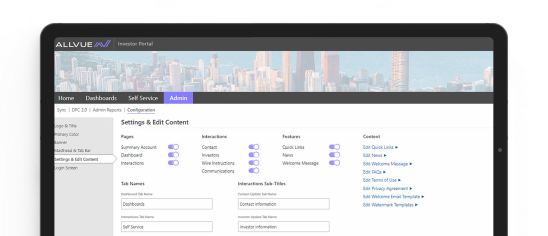
By: Allvue Team
March 12, 2024
Private equity is one of many forms of private capital that helps finance companies in periods of growth or financial uncertainty. By investing in these companies, private equity firms and investors take ownership stakes, which allow them to add value to these companies.
Alternative investments like private equity help companies in need of financing to access investor funds quickly while offering opportunities for value creation. Following the aftermath of the 2008 financial crisis, the lending market became more risk-averse, creating barriers for organizations to access credit financing, which eventually drove the growth of alternatives like private capital.
So, how exactly does private equity value creation work?
What is private equity value creation?
When general partners (GPs) at a private equity firm purchase enough shares to assume ownership of a given company, they acquire and control its assets, which allows them to identify growth opportunities and optimize the strategies that are working (leaving behind those that aren’t). At the time of acquisition, these assets may have diminished value, depending on the acquired company’s balance sheet and other factors.
So, in most cases, a private equity firm is not just investing capital, per se. By taking the company private and controlling the majority of its equity, GPs invest their expertise to create value and maximize long-term gains when they sell the company’s assets or prepare it for an initial public offering (IPO). The success of either outcome depends on the company’s value in the eyes of investors.
And that’s where value creation comes in.
Why is value creation important?
Value creation is critical to increasing the premium buyers or investors are willing to pay for shares when a company is listed on the stock exchange or sold privately. Since markets are volatile and can be unpredictable when defining value, companies must have strong portfolios that undeniably demonstrate value to investors.
Many factors influence the value of a company’s assets, ranging from revenue growth to higher profit margins to improved valuations. These factors work hand in hand to validate the premium placed on a company or its assets when offered up for sale to interested buyers. Upon identifying these growth drivers, GPs at private equity firms can create value across the companies they acquire before selling them off for significant profits.
Private equity value creation can also be considered a way to build new infrastructure with existing blocks requiring re-configuration. Armed with the expertise, oversight, and capital provided by the private equity investor, there are new possibilities for companies to optimize their existing offerings. These companies could even break into entirely new markets, which can be a game-changer for how much value they provide in their specific industry.

The private equity value creation process
So, how can private equity investors create long-term value for the companies to which they provide capital?
Let’s explore four fundamental processes:
- Revenue growth – Increasing an underperforming company’s revenue starts with identifying unexplored opportunities, which may require research into product or asset development, expanding into new markets, or scaling processes to improve efficiencies.
- Margin expansion – Similarly, identifying operational inefficiencies that limit productivity may point to bottlenecks in realizing higher profit margins. Ultimately, speeding up production without hindering product quality enhances profit margins for each product buyer’s purchase, which boosts the profit margin realized per product.
- Increased valuation – Although a company’s valuation depends on multiple factors, it’s crucial for the percent revenue growth reported to reach or exceed that of publicly listed companies, resulting in a higher valuation.
- Capital structuring – Optimizing the capital structures of acquired companies can help increase their cash flows, which maintains a constant supply of capital during phases of rapid expansion and ultimately boosts their valuations.
These processes will help private equity firms maximize the value they create when investing in various asset types, regardless of industry. And as the market conditions evolve, chances are some of these processes will be more critical to value creation.
Importantly, there must be synergy between the GPs overseeing these processes and the teams on the ground implementing them. Both parties should realize there will be a combination of experimentation and optimization in private equity value creation.
Private equity investment strategies
When creating and maximizing the value of their private equity investments, firms may also choose to leverage various strategies, including:
Buyouts
A buyout refers to an investment of capital into owning a mature company, which enables a private equity firm to determine the path forward for that company’s assets. Sometimes, private equity firms may partner with other entities to buy these companies, collectively increasing their value over time.
The different buyouts include:
- Take private buyout – With this type of buyout, a publicly traded company is delisted from the stock exchange, and its shareholders are paid off before the company becomes privately owned and operated.
- Private company buyout – By purchasing a controlling stake in a privately owned company, an investor can add value to it for long-term growth before selling it off or putting it up for an IPO.
- Leveraged buyout – In some cases, private equity firms may use leverage equity and debt financing to purchase ownership of a company, securing the loans using the acquired assets.
Growth capital
Another way to add value to a growing company is to provide it with private capital to sustain its growth and expansion efforts while owning a minority of its overall equity.
The value creation here is primarily monetary and helps drive large-scale projects such as customer acquisition, expansion into new markets, or other capital expenses the company would have been unable to finance by itself.
Distressed asset investments
Private equity firms can also invest in financially distressed companies with significant amounts of debt they cannot finance with existing capital. These assets tend to carry higher risk because a company could file for bankruptcy soon after a private equity firm invests capital in the assets.
Depending on the company or asset in which a private equity firm invests, the value creation might be primarily financial or, in some cases, a combination of expertise and capital.
Measuring private equity performance
Evaluating the performance of private equity investments comes down to several key performance indicators (KPIs):
- Internal rate of return (IRR) – As a capital budgeting and portfolio management KPI, IRR determines the future cash flows of an investment relative to its cost. Therefore, a high-performing investment has a high IRR because there is more cash flow than the cash investments required to sustain the investment.
- Multiple on invested capital (MOIC) – Using MOIC, private equity fund managers can calculate the overall return realized from an investment based on the total returns generated from the capital invested in an asset.
- Return on investment (ROI) – Investors are more likely to invest in an asset that yields a high ROI simply because that asset provides more value over time and is considered more profitable. ROI is calculated as the benefit of investing in an asset relative to the cost of the investment.
These KPIs are often used in the investment world and can help private equity investors understand the value and profitability of investing in certain asset types or classes. In the context of private equity value creation, firms can demonstrate the value of their investments by reporting on these KPIs to current and potential investors.
Challenges in private equity value creation
Although private equity provides opportunities for firms and other investors to add value to the companies they invest in, there are still challenges that can impact the growth of these investments.
One of the main challenges is market volatility, which can impact investor sentiment regardless of the value of an asset. Considering the volume of extrinsic factors that could determine market conditions, private equity firms can only create as much value as possible when preparing for an IPO and demonstrate it to potential investors irrespective of volatile markets.
It’s also challenging to predict changes in regulations, which can influence aspects of private equity investing, especially when planning to sell a company’s assets to buyers. For instance, the Securities and Exchange Commission (SEC) recently announced changes to regulations around the transparency of private funds investments and the preferential treatment given to investors.
Often, private equity firms struggle to manage internal operations during the acquisition of certain assets, which can then impact value creation in the long term. With limited resourcing and expertise, it can become challenging to identify new opportunities to add value to newly acquired companies.
Add value to private equity investments with Allvue
Private equity value creation will help increase the profitability of an investment and help fund managers sell it off at a premium. But it all starts with using the right tools to ensure you methodically build value over time without compromising existing operations at the acquired company.
With the help of the latest tech, Allvue’s private equity software helps private equity firms add value to and report on their investments faster.
Request a demo to see Allvue’s tools in action.
Sources:
Goldman Sachs. The New Math of Private Equity Value Creation. https://www.gsam.com/content/gsam/us/en/institutions/market-insights/gsam-insights/perspectives/2023/the-new-math-of-private-equity-value-creation.html#section-#history
Investopedia. Net Internal Rate of Return: Definition, Uses, and Example. https://www.investopedia.com/terms/n/net-internal-rate-of-return.asp
Investopedia. Realization Multiple: What it is, How it Works, Formula. https://www.investopedia.com/terms/r/realization_multiple.asp
Investopedia. Return on Investment (ROI): How to Calculate It and What It Means. https://www.investopedia.com/terms/r/returnoninvestment.asp
SEC. SEC Enhances the Regulation of Private Fund Advisers. https://www.sec.gov/news/press-release/2023-155


